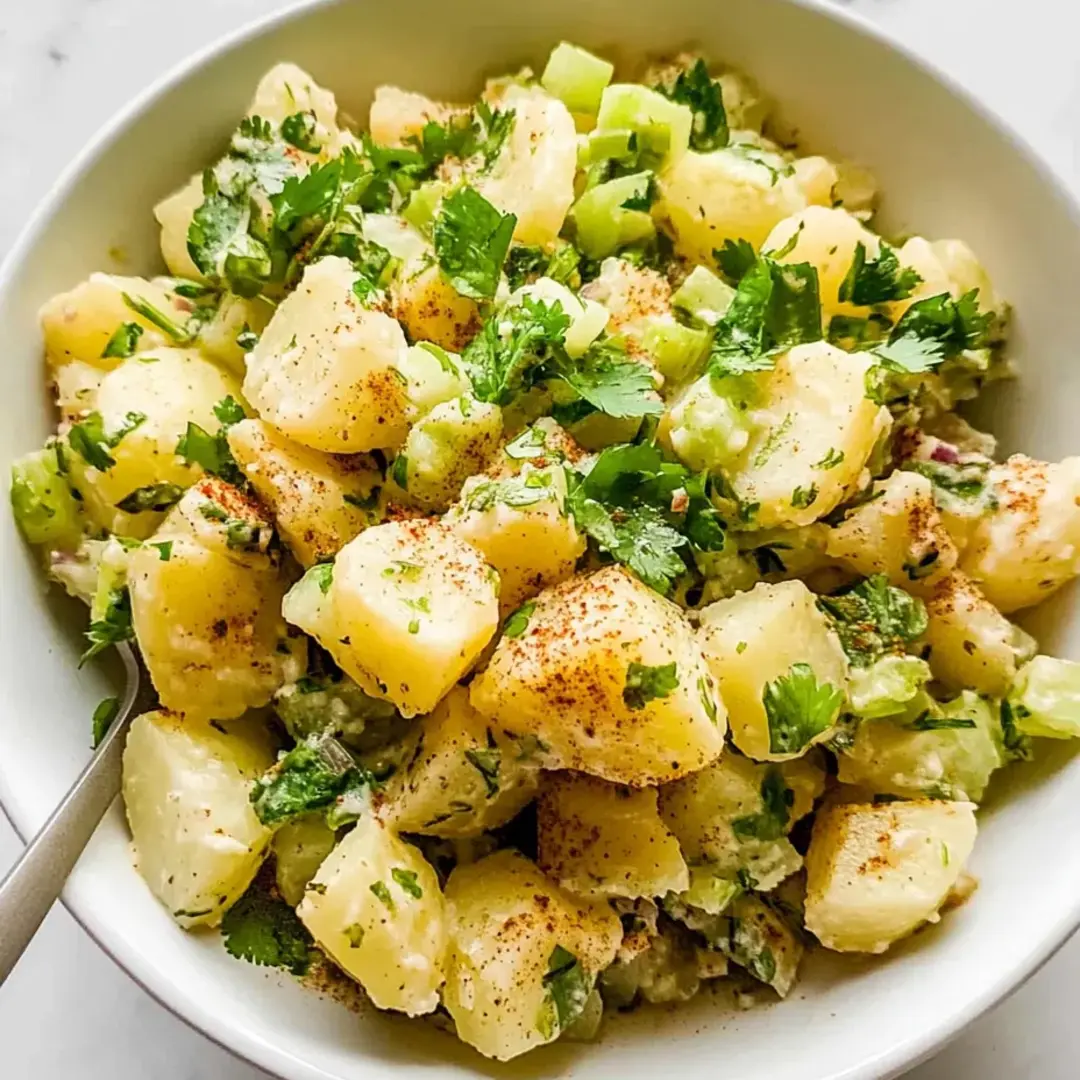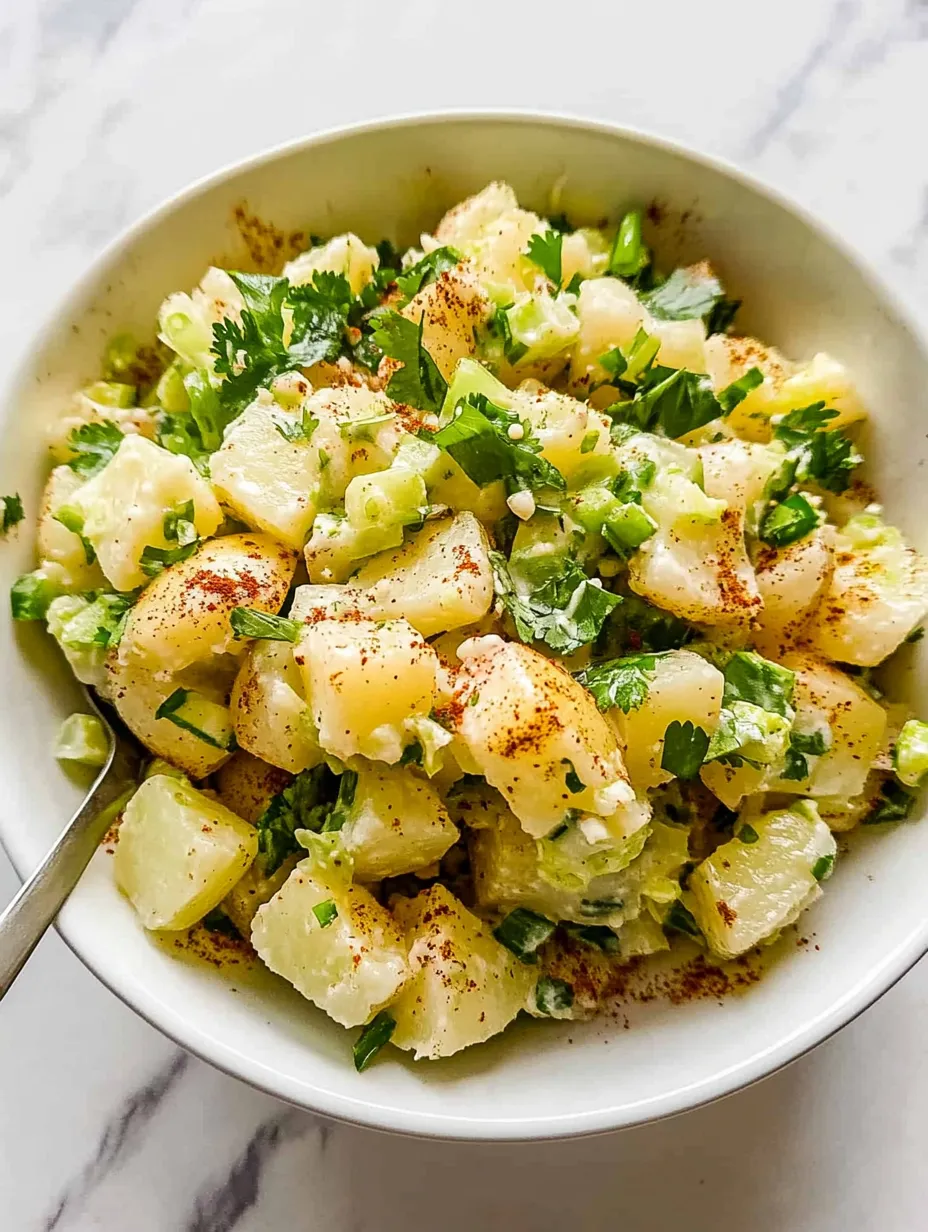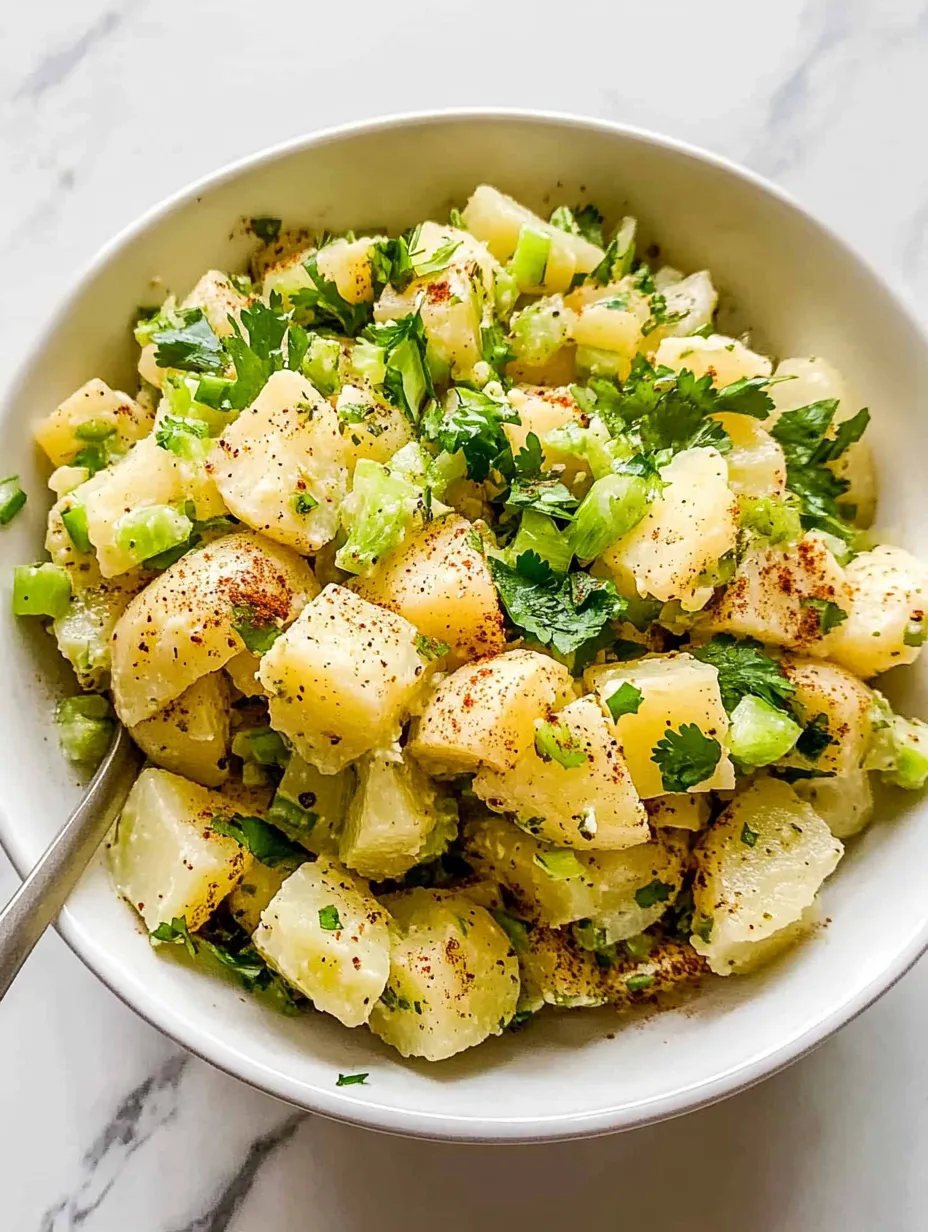 Pin it
Pin it
This vibrant Turkish Potato Salad (Patates Salatası) offers a refreshing departure from mayo-heavy versions while delivering incredible depth of flavor in every bite. Tender chunks of potato serve as the perfect canvas for crisp bell peppers, fresh green onions, and an abundance of aromatic herbs. What truly elevates this dish is the brilliant combination of zesty sumac and gently spiced Aleppo pepper, which infuse the salad with distinctive Mediterranean character. Finished with a simple dressing of quality olive oil and fresh lemon juice, this light yet satisfying dish balances hearty comfort with bright, clean flavors. Perfect for summer gatherings, mezze spreads, or as a substantial side to grilled meats, this potato salad proves that simple ingredients can create truly extraordinary results.
I first encountered this salad during a visit to a small coastal town in Turkey, where it was served alongside grilled fish at a family-run restaurant. After one bite, I was captivated by how the bright, citrusy notes of sumac transformed ordinary potatoes into something truly special. Back home, I've made this salad countless times, tweaking the proportions until I achieved that perfect balance of flavors I remembered. What I love most is how it combines the comforting heartiness of potatoes with the fresh, vibrant character of a Mediterranean salad – satisfying without being heavy. It's become my go-to contribution for summer potlucks, where even guests who claim to "not like potato salad" find themselves coming back for seconds.
Key Ingredients
- Russet potatoes: Their fluffy texture absorbs the dressing beautifully; you can substitute Yukon Gold or Red potatoes for a firmer texture
- Green bell pepper: Adds fresh crunch and subtle sweetness; traditionally green peppers are used, but any color works well
- Green onions: Contribute a mild onion flavor without overwhelming the dish; both the white and green parts are used
- Fresh parsley: Brings brightness and color; don't discard the stems as they add wonderful flavor and texture
- Fresh mint: Its cooling quality balances the heat from the pepper; be sure to use only the leaves as the stems are bitter
- Sumac: This bright, lemony spice is essential for authentic Turkish flavor; its deep red color also adds visual appeal
- Aleppo pepper: Provides moderate heat with fruity undertones; red pepper flakes can substitute in a pinch
- Extra virgin olive oil: Forms the base of the simple dressing; use the best quality you can find for superior flavor
- Fresh lemon juice: Adds necessary acidity that brightens all the other flavors; always use freshly squeezed
 Pin it
Pin it
Detailed Cooking Instructions
- Step 1:
- Begin by filling a large pot with water, adding at least 1 tablespoon of salt, and bringing it to a rolling boil. The generously salted water is crucial as it seasons the potatoes from the inside out while they cook.
- Step 2:
- While waiting for the water to boil, prepare 3 pounds of Russet potatoes by washing them thoroughly but leaving the skins on. The skins will help prevent the potatoes from absorbing too much water during cooking, resulting in a better texture for your salad.
- Step 3:
- Carefully add the whole potatoes to the boiling water and reduce the heat to maintain a steady simmer. Cook the potatoes for approximately 20-30 minutes, depending on their size. To test for doneness, insert a fork into the largest potato—it should slide in easily but the potato shouldn't fall apart.
- Step 4:
- While the potatoes are cooking, prepare the vegetables and herbs. Finely dice 1 green bell pepper into approximately ¼-inch pieces. The uniform small dice ensures that every bite of salad will include some of the pepper's fresh crunch and flavor.
- Step 5:
- Trim 4 green onions and slice them thinly, using both the white and green parts. The white portions provide a stronger onion flavor, while the green parts add color and a milder taste.
- Step 6:
- Wash and dry ⅓ cup of fresh parsley and 2 tablespoons of fresh mint leaves. Finely chop the parsley, including the stems which add wonderful flavor and texture. For the mint, remove the stems (which can be bitter) and chop only the leaves.
- Step 7:
- Once the potatoes are fork-tender, drain them in a colander and allow them to cool until you can handle them comfortably, about 15-20 minutes. This cooling period is important as it allows the potatoes to firm up slightly, making them easier to dice without falling apart.
- Step 8:
- When the potatoes are cool enough to handle, gently peel away the skins using your fingers or a paring knife. The skins should slip off relatively easily after cooking. Cut the peeled potatoes into large chunks, approximately 1-inch cubes. Try not to overwork them to prevent them from becoming mushy.
- Step 9:
- In a large mixing bowl, gently combine the diced potatoes, green pepper, green onions, chopped parsley, and mint. Use a large spoon or spatula to fold the ingredients together, being careful not to break up the potato chunks too much.
- Step 10:
- Drizzle 3 tablespoons of high-quality extra virgin olive oil and 1 tablespoon of freshly squeezed lemon juice over the salad. The olive oil provides richness while the lemon adds a bright acidity that enhances all the other flavors.
- Step 11:
- Sprinkle 2 teaspoons of sea salt, 1 teaspoon of sumac, and 1 teaspoon of Aleppo pepper evenly over the salad. The sumac adds a citrusy tang while the Aleppo pepper brings a gentle, fruity heat to the dish.
- Step 12:
- Using a large spoon or your hands, gently toss all the ingredients until they are well combined and the potatoes are evenly coated with the dressing and spices. Take care not to overmix, which could break down the potatoes.
- Step 13:
- Taste the salad and adjust the seasonings if necessary, adding more salt, sumac, or lemon juice according to your preferences. Remember that the flavors will develop as the salad sits, so it's better to slightly under-season at this stage.
- Step 14:
- For the best flavor, allow the salad to rest at room temperature for about 30 minutes before serving. This resting time allows the potatoes to absorb the dressing and the flavors to meld together harmoniously.
- Step 15:
- Just before serving, give the salad a gentle toss to redistribute the dressing that may have settled at the bottom of the bowl. Transfer to a serving dish and garnish with a sprinkle of additional sumac and a few fresh herb leaves for visual appeal.
The Perfect Balance of Spices
What truly sets Turkish Potato Salad apart from other versions is its distinctive spice profile. The star ingredient is sumac, a deep red spice with a bright, lemony flavor that's commonly used throughout Middle Eastern and Mediterranean cuisine. Its tangy notes complement the earthy potatoes perfectly while adding a beautiful visual element to the dish. Paired with sumac is Aleppo pepper, which brings a moderate heat with subtle fruity undertones that's less aggressive than red pepper flakes or cayenne. This balanced approach to spicing is characteristic of Turkish cuisine, where flavors are bold but harmonious. I've found that letting the salad rest for about 30 minutes before serving allows these spices to fully infuse the potatoes, resulting in a more well-rounded flavor profile. For those unfamiliar with these spices, they're increasingly available in well-stocked supermarkets or specialty stores, and they're well worth seeking out as they'll transform not just this salad but countless other dishes in your culinary repertoire.
 Pin it
Pin it
Serving Suggestions for a Complete Meal
This versatile Turkish Potato Salad shines in a variety of dining contexts. In Turkey, it's often served as part of a mezze spread alongside other small dishes like hummus, baba ganoush, and stuffed grape leaves. This approach makes for a wonderful casual dinner party setup where guests can sample a little of everything. For a more substantial meal, I love pairing it with grilled meats, particularly lamb or chicken seasoned with similar Mediterranean spices that complement the flavors in the salad. During summer months, it makes an excellent side for a barbecue, offering a refreshing alternative to heavier, mayo-based sides. For a light lunch, I sometimes add a protein element directly to the salad—flaked poached salmon or grilled halloumi cheese work beautifully. The salad travels well, making it perfect for picnics or potlucks, and unlike mayo-based versions, it can sit out a bit longer without food safety concerns. Consider serving it with warm flatbread and a simple yogurt sauce for a complete and satisfying vegetarian meal.
Make-Ahead and Storage Tips
One of the many virtues of this Turkish Potato Salad is how well it holds up over time. In fact, the flavors often improve after the ingredients have had a chance to meld together. You can prepare the salad up to 24 hours in advance and store it covered in the refrigerator. If making ahead, I recommend holding back about one-third of the dressing and adding it just before serving to refresh the flavors. Allow the salad to come to room temperature before serving, as cold temperatures dull the nuanced spice flavors. The salad will keep well for up to 4 days in an airtight container in the refrigerator, making it excellent for meal prep. Unlike mayo-based potato salads, this version is also more suitable for outdoor events where food might sit out for longer periods. If you find the salad has dried out slightly after storage, a small drizzle of additional olive oil and a squeeze of lemon juice will revive it beautifully.
I discovered by happy accident that adding a teaspoon of pomegranate molasses to the dressing creates an incredible depth of flavor that complements the sumac beautifully. One day when making this recipe, I was short on lemon juice and remembered the bottle of pomegranate molasses in my pantry. The sweet-tart flavor enhanced the sumac's citrusy notes while adding a subtle fruitiness that brought the whole dish together. Now it's my "secret ingredient" that always has guests trying to identify that special something!
This Turkish Potato Salad has become my signature contribution to summer gatherings – the dish friends request when they visit and the recipe most frequently shared from my kitchen. There's something deeply satisfying about transforming humble ingredients into a dish that feels both exotic and comforting. The bright flavors transport you to the Mediterranean coast, while the hearty potatoes ground the dish in familiar territory. Whether you're looking to expand your culinary horizons or simply seeking a fresher take on potato salad, this recipe offers a delicious journey into Turkish cuisine that's accessible to cooks of any skill level. As they say in Turkey, "Afiyet olsun!" (Enjoy your meal!)
Frequently Asked Questions
- → What makes Turkish potato salad different from American potato salad?
- Turkish potato salad uses olive oil and lemon juice instead of mayonnaise, making it lighter and dairy-free. It's also flavored with distinctive spices like sumac and Aleppo pepper, and fresh herbs like mint and parsley for a bright Mediterranean flavor profile.
- → Where can I find sumac and Aleppo pepper?
- Both spices can be found at Middle Eastern grocery stores, specialty spice shops, or online retailers. If you can't find Aleppo pepper, you can substitute with a mix of sweet paprika and a pinch of cayenne or regular red pepper flakes.
- → Can I make this potato salad ahead of time?
- Yes, this salad actually improves with a little time as the flavors meld. You can make it up to 24 hours in advance and store it in the refrigerator. Just bring it to room temperature before serving for the best flavor.
- → Is this potato salad served hot or cold?
- Turkish potato salad is traditionally served at room temperature or slightly chilled, but not cold from the refrigerator. The flavors come through best when it's not too cold.
- → What dishes pair well with Turkish potato salad?
- This versatile salad pairs beautifully with grilled meats like kebabs, köfte (Turkish meatballs), grilled fish, or as part of a mezze spread with hummus, stuffed grape leaves, and pita bread. It's also perfect for picnics or barbecues.
